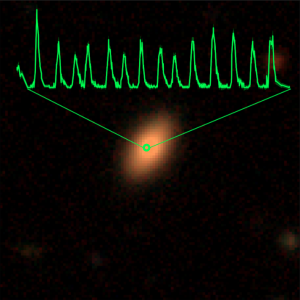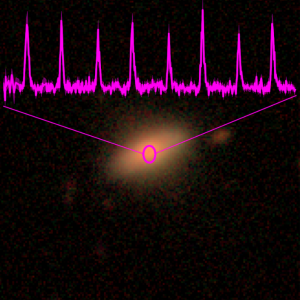Using the eROSITA X-ray facility, installed onboard the Spektr-RG satellite, a team of international scientists has found two previously quiescent galaxies that now show quasi-periodic eruptions. The nuclei of these galaxies light up in X-rays every few hours, reaching peak luminosities comparable to that of an entire galaxy. The research results have already been published in the journal “Nature”. Dr. Mariusz Gromadzki from the Astronomical Observatory of the University of Warsaw is a team member and co-author of the publication.
Most of the galaxies in the Universe contain supermassive black holes (SMBHs) in their centres. When galaxies resemble our Milky Way, masses of SMBHs are between a hundred thousand to a few million solar masses. The mass of the black hole in the centre of our Galaxy is equal to ca. five million solar masses. Black holes do not emit any light, and to detect them, astronomers carefully study matter in their closest neighbourhood. There are also galaxies, which contain significantly more massive central black holes (approaching even a few hundreds of millions of solar masses). They are consuming enormous amounts of matter via accretion disk, which surround them. Most inner regions of these disks are extremely hot and emit immense numbers of highly energetic photons, often a few times larger than all stars in the host galaxy. They are called Quasars or “active galactic nuclei” (AGN), and they are the brightest objects in the Universe.
The eROSITA telescope currently scans the entire sky in X-rays, and the continuous data are well suited to look for transient events such as these eruptions. Both new sources discovered by eROSITA showed high-amplitude X-ray variability within just a few hours. That was confirmed by follow-up observations with the XMM-Newton and NICER X-ray telescopes.
Contrary to the two previously known similar objects, the host galaxies of these new sources found by eROSITA did not show any signs of previous black hole activity. In the case of two previously known sources, their hosts are AGNs and outbursts were explained by processes undergoing in pre-existing accretion disks. Mechanisms of X-ray eruptions in newly discovered targets are still unclear. However, quasi-periodic emission such as the one discovered by eROSITA is typically associated with binary systems. If these eruptions are indeed triggered by the presence of an orbiting object, its mass has to be much smaller than the black hole’s – of the order of a star or even a white dwarf, which might be partially disrupted by the huge tidal forces close to the black hole at each passage. Future X-ray observations will help to constrain or rule out the “orbiting object scenario” and to monitor possible changes in the orbital period. As these galaxies are relatively close and small, this discovery could help scientists to understand better how black holes are activated in low-mass galaxies.
Publication in “Nature”
The first author is Riccardo Arcodia, doctoral candidate at the Max Planck Institute for Extraterrestrial Physics (MPE). Dr. Mariusz Gromadzki from the Astronomical Observatory of the University of Warsaw is a team member and co-author of the publication too. He processed optical spectra of central regions of host galaxies obtained with the 10-meters South African Large Telescope. These data allowed estimating distances to the targets and energy emitted during eruptions.




